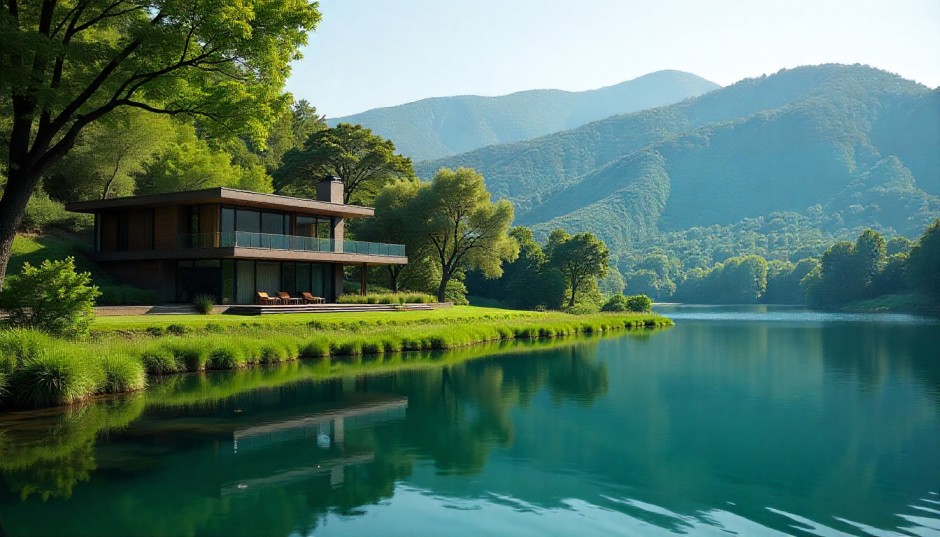
Blog
We keep you up to date on the most recent real estate news and events.
Designing for the Views: How Forests & Water Bodies Shape Your Home Plan
Homes near forests and water don’t just look better—they live better. Cooler microclimates, cleaner air, and the calming presence of nature turn everyday life into something healthier and more balanced. It’s no surprise, then, that across India, buyers are paying a premium for homes with clear views of green belts, lakes, and forest corridors. And this shift isn’t driven by prestige alone. Research shows that such environments improve air quality, reduce urban heat, and enhance mental well-being. The smartest developers are responding to this demand by reimagining design itself—planning homes, facades, and entire townships from the view outwards, making nature the first blueprint rather than the final add-on.
Design that starts at the window
Sit by a window that frames a stand of trees or a quiet lake and breathe in the changes before any gadget measures them; the view invites slower mornings, softer light, and a daily nudge to step outside—wellness by design, not by subscription. Good planning treats that view as the primary asset: orient rooms to it, slide living spaces towards it, and let breezes from water and woods choreograph how a house feels from dawn to dusk.
Why green and blue matter
- Health outcomes: Reviews led by the WHO link accessible urban green to lower stress, better mental health, and reduced all‑cause mortality through pathways like physical activity, heat relief, and cleaner air exposure; it’s not a trend, it’s epidemiology in action.
- Mental health lift: Systematic work shows greener residential buffers correlate with lower mortality risk—about a 4% drop in all-cause mortality per 0.1 increase in greenness index (NDVI) in longitudinal cohorts, signalling a meaningful effect size for everyday exposure.
- Blue space effect: Regenerated canals and lakes near homes have been associated with improved mental health and a moderation of deprivation‑linked risks, indicating water views can buffer stress and support wellbeing over the long term.
The microclimate advantage
- Forests cool cities: Urban trees reduce air temperatures and dampen heat stress; meta‑analyses across climates show tree belts consistently deliver cooling, especially in open, mixed‑use zones where air can flow and canopies can spread.
- Water shapes breeze: Lakes and large ponds increase local humidity, stabilise temperatures, and, downwind, enhance ventilation due to lower surface roughness—a design that captures prevailing breezes from the water side feels fresher with less mechanical cooling.
- Street geometry + canopy: Indian studies highlight how canopy height and street aspect ratios influence comfort; the right combination of shade trees and setbacks can materially drop thermal stress on footpaths and verandahs.
Designing for the view, step by step
- Site reading: Walk the plot at 7 am, 3 pm, and 7 pm—note sun paths, lake breezes, and forest shade lines; mark where light is soft but present, and where wind funnels naturally.
- Orient to nature: Put primary living and sleeping spaces facing the forest or water edge; use deep verandahs and recessed glazing to frame views while limiting glare and heat gain.
- Plan the section: Stack volumes to “step down” towards the view so upper floors don’t overshadow ground‑level courts; modulate slab overhangs to catch winter sun and block peak summer angles.
- Cross‑ventilation: Align operable windows to the water‑side breeze and a leeward exhaust; locate internal courtyards as thermal chimneys to draw air across the plan without overcooling.
- Acoustic calm: Use planting mounds, water rills, and layered hedges at the perimeter to soften road noise so the audible foreground remains birdsong and water rather than traffic.
- Glare and reflectance: Lakes amplify light; use matte finishes, light‑coloured shading devices, and exterior screens to keep interiors calm while retaining horizon depth.
Wellness by layout, not slogans
- Daily dose of nature: Regular exposure to green reduces stress, anxiety, and depressive symptoms; even passive viewing through windows counts, especially for elders and those with limited mobility—design should treat the window as a wellness device.
- Outdoor rooms that work: Pergola‑shaded decks facing the green, east‑oriented breakfast courts, and evening terraces toward the lake extend living time outdoors, nudging physical activity without “gym time”.
- Sleep and circadian rhythm: Morning light on the bed wall and evening dimness in family areas reinforce sleep cycles, aiding recovery and mood. Set glazing and shading to this rhythm, not only to the façade symmetry.
The air we breathe
Air pollution is a significant constraint in Indian cities, making micro-siting and tree cover even more valuable. Evidence shows that access to nature is linked to reduced exposure to pollutants, heat, and noise, which is particularly relevant in areas with fluctuating ambient AQI. Homes that place fresh‑air intakes on the forest‑facing side, shield parking courts, and use vegetated buffers reduce indoor pollutant ingress and thermal load through the worst months.
Blue‑edge cautions: beauty with boundaries
- Humidity management: Near lakes, control moisture with breathable wall assemblies, ventilated cavities, and dehumidification in monsoon months; position wardrobes and pantries on drier cores.
- Mosquito control: Design for positive drainage, covered rain barrels, and moving water features rather than stagnant basins; landscape with species less attractive to vectors and ensure night airflow without open standing water.
- Fire season realities: In some forest belts, particulate spikes occur during fire episodes; plan secure shut‑down modes with filtered mechanical ventilation that can bridge the event window without suffocating the plan.
Biophilic detailing that earns its keep
- Material palette: Timber tones, textured stone, and plantable ledges tie interiors to the outside without kitsch; the goal is calm, not theme.
- Multi‑sensory cues: Frame a “borrowed landscape” view, add a sound of moving water in a shaded court, and use fragrant species along night paths to make returning home a decompression ritual.
- Wildlife‑friendly edges: Low fencing, native understory, and dark‑sky lighting keep corridors usable for birds and small fauna while protecting privacy—a design that respects the sanctuary next door.
Panchkula’s foothill lens (applies across India’s green belts)
At Chandigarh’s edge, Sukhna Lake and its sanctuary show how conserved catchments shape daily life: a protected wetland since 1988 with a re‑vegetated Shivalik catchment, wintering birds, and a quiet lakeside promenade—proof that water and forest management can anchor a city’s wellness culture for decades. For homes along such belts, view‑led planning isn’t indulgence; it’s aligning the plan with the landscape’s long memory.
Room‑by‑room playbook
- Living/dining: East‑north‑east glazing to catch soft morning light; deep overhangs and external screens to hold down afternoon heat; frame a single, uninterrupted sightline to water or woods to reduce visual clutter.
- Kitchen: Cross‑vented, leeward exhaust aligned to prevailing breeze; herb court near the wet zone to encourage small, daily outdoor steps.
- Bedrooms: Orient primary suites to the quiet green; provide operable upper vents to purge hot air at night and maintain dark‑sky blinds for sleep hygiene.
- Study: Side‑lit desks with long focal depth toward the canopy; avoid direct lake glare; integrate a small standing deck to break screen time.
- Bathrooms: Stack wet walls away from the most valuable façade; use clerestory light from the view side to keep the day’s first light natural without sacrificing privacy.
- Stairs and halls: Treat circulation as a gallery for the view—slot windows, light shelves, and high vents keep these spaces bright and breezy without mechanical load.
Construction details that pay back
- Roofs: High‑albedo, ventilated roofs with radiant barriers reduce top‑floor heat; solar canopies double as shade over terraces facing the water.
- Walls: Insulated cavity walls on the west/south‑west; breathable plasters in humid belts; rain‑screen cladding where wind‑driven rain is frequent.
- Windows: Low‑E glazing on harsh exposures; larger, precise openings on the forest/water side with insect screens sized for airflow; external shading beats internal blinds for heat control.
- Landscape: Native canopy + understory layering; bioswales to move stormwater; permeable paving to keep courtyards cool underfoot.
Developer lens: planning communities around views
For townships at green edges, master plans that reserve continuous green spines along the water/forest, protect view corridors from over-massing, and maintain dark-sky lighting create quiet, valuable streets that market themselves every evening. Amenities should sit where breezes are strongest and shade is deepest; the rest of the plan should follow the wind and the trees.
Located at the foothills of the Shivaliks, Trident Hills embodies this philosophy. Spread over 200 acres, the township integrates:
- Forested trails spanning 5 km, encouraging daily activity amidst greenery.
- The area's proximity to water systems, such as Sukhna Lake and choes (seasonal streams), naturally influences its air quality and climate.
- Plot layouts are designed to preserve sightlines of hills and woodlands, ensuring long-term view stability.
Unlike typical city projects, where “greenery” is often restricted to manicured lawns, Trident Hills leverages living forests and natural hydrology, making views an integral part of everyday life rather than decorative add-ons.
Conclusion
When a home is planned around forests and water, wellness stops being an app and starts being a habit—cooler evenings, calmer minds, and a view that quietly resets the day. That’s exactly the promise Central Vista at Trident Hills leans into in Panchkula’s Shivalik edge: serviced plots with a daily green‑and‑blue backdrop, walkable leisure, and a streetscape designed to stay serene as life gets busier. For those weighing where to place long‑term capital, this is the rare blend—nature‑led living today, land‑led compounding for tomorrow—making Central Vista a simple, confident next step rather than a complicated bet.
Interested in investing in plots surrounded by waterbodies and forest trails? Check out Central Vista by Trident Hills.
Sources with links
- WHO, Urban green spaces and health—mechanisms and evidence for mental and physical benefits. https://www.who.int/europe/publications/i/item/WHO-EURO-2016-3352-43111-60341 and full report PDF. https://iris.who.int/bitstream/handle/10665/345751/WHO-EURO-2016-3352-43111-60341-eng.pdf.iris.who+1
- Systematic review: Greenness and all‑cause mortality reduction per 0.1 NDVI. https://pmc.ncbi.nlm.nih.gov/articles/PMC6873641/.pmc.ncbi.nlm.nih
- Blue space and mental health: longitudinal evidence from canal regeneration. https://www.nature.com/articles/s41598-022-17089-z and freshwater blue space wellbeing. https://www.sciencedirect.com/science/article/pii/S0169204622000950.nature+1
- Microclimate near water bodies: ventilation, cooling and humidity effects; design with prevailing winds. https://pmc.ncbi.nlm.nih.gov/articles/PMC9690114/.pmc.ncbi.nlm.nih
- Street geometry, canopy and cooling in India: Madurai microclimate study. http://www.ceser.in/ceserp/index.php/ijed/article/view/4653.ceser
- Cooling efficacy of trees across cities: synthesis across climates. https://www.nature.com/articles/s43247-024-01908-4.nature
- Nature exposure and mental health: 2024 updates. https://pmc.ncbi.nlm.nih.gov/articles/PMC10940342/.pmc.ncbi.nlm.nih
- India air pollution burden context. https://pmc.ncbi.nlm.nih.gov/articles/PMC11463883/.pmc.ncbi.nlm.nih
- Window‑view wellbeing initiative. https://www.ecehh.org/news/scientists-want-your-view-on-watching-nature-through-the-window/.ecehh
- Panchkula lens: Sukhna Lake history, wetland status and sanctuary context. https://www.gjimt.ac.in/sukhna-lake/ and overview of Sukhna Wildlife Sanctuary context. https://lotusarise.com/inshorts/sukhna-lake-sukhna-wildlife-sanctuary-upsc/.lotusarise+1
- Biophilic design reviews and Indian applicability. https://africanjournalofbiomedicalresearch.com/index.php/AJBR/article/download/6408/5115/12419 and https://journalajee.com/index.php/AJEE/article/view/548.journalajee+1